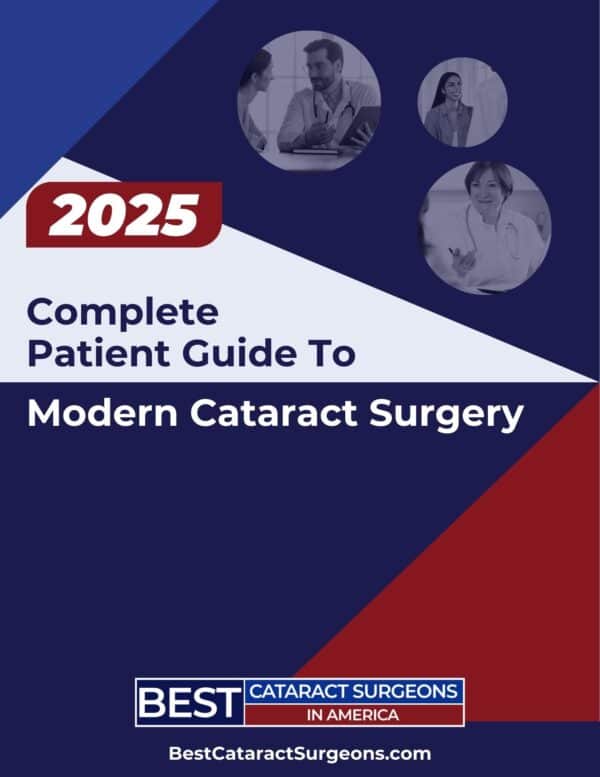There are many reasons why so many of the “Best Cataract Surgeons in America” perform laser cataract surgery, and find it to be superior to surgery done only by hand.
Simply put… Laser cataract surgery is more precise & consistent than the human hand for the delicate steps of the procedure… This leads to safer surgery & better vision outcomes for patients.
The difference between a lifetime of crystal clear vision… or a vision-threatening complication… can be fractions of a millimeter. When the delicate steps of modern cataract surgery are performed with the precision of a computer-guided laser, these critical steps of the procedure are performed more consistently and accurately.
In our “Complete Guide To Laser Cataract Surgery”, we’re going to tell you why choosing laser cataract surgery may be the right decision for your eyesight.
Some things in life are too important… Get it done right.
What’s The Alternative To Laser Surgery For Cataracts?
First, let’s talk about how your surgery will be done if your surgeon doesn’t offer laser cataract surgery… Basically, your surgeon will perform the delicate steps of the surgery by hand. This is sometimes called “traditional cataract surgery”. Prior to the use of lasers, cataract surgery was only performed by hand for many years. While in the hands of an experienced surgeon, manual cataract surgery can be a safe & effective procedure, however, the human hand simply cannot match the consistency and precision of computer-guided laser systems.
Technology has made virtually every aspect of modern medicine better. Cataract surgery is no exception. Lasers have been used in various eye treatments and surgeries for decades. The computers, imaging systems, and laser technology in state-of-the-art laser cataract systems have been in use for many years now, and have resulted in higher quality outcomes for countless patients.
Next let’s get into the details of what makes laser cataract surgery a superior option for most patients when used in the hands of an experienced laser cataract surgeon.
Laser Cataract Surgery Is Computer-Guided Surgery – Safety First!
Cataract surgery is “microsurgery”. This means that many of the steps are extremely delicate, and the margin of error for the human hand is fractions of a millimeter. Laser systems use advanced imaging technology and computer systems to perform these delicate steps with precision and consistency that the human hand simply can’t compare to.
One of the first steps that the laser cataract system performs during your surgery is imaging of your cataract. The laser systems have cameras that take high-resolution pictures of the front part of the eye, including the cornea, anterior chamber, and cataract. Similar to a CT scanner, the computer can then combine these images into a 3D image of the front part of the eye. Finally, the laser is able to precisely apply its energy to these structures to perform the delicate steps of the surgery… without the need for sharp blades… using only the energy from light with computer-guided precision.

Figure 1.
Laser cataract systems use advanced imaging systems to “see inside the eye”, to see details impossible for your surgeon to see with such advanced technology. The light waves can actually “see through” the cataract to the precise location of the posterior capsule and space behind the cataract.

Figure 2.
The laser cataract system’s computer processes the images to identify the pupil, cornea, front & back lens surface. Multiple cross-sectional images are taken, and then reconstructed similar to a CT scanner, to show a 3-D model of the cataract and front part of the eye.
Cataract Surgery With a Laser Is Bladeless Surgery
That’s right… In the past, sharp instruments held in the human hand had to be used to perform these delicate steps. A laser is simply a special type of light… and light has energy in it. By focusing laser light in a precise pattern, the energy from the light is able to perform these steps in an automated and completely bladeless manner… and all that you’ll notice as a patient is a quick, completely painless, light show.
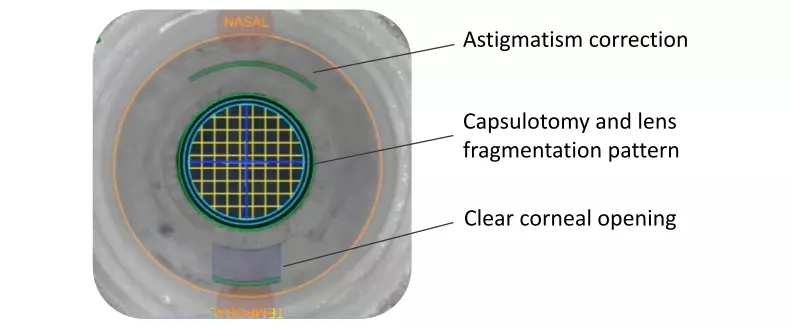
Figure 3.
No more blades. The surgical planning screen shows precisely where laser energy will be applied to create the clear corneal opening, astigmatism correction, capsulotomy, and lens fragmentation pattern. Your surgeon can customize the laser treatment plan to your eye.
Laser Cataract Surgery is More Precise and More Consistent
When it comes to cataract surgery… precision matters. Precision can mean the difference between routine surgery and a great outcome… or having a complication.
Lasers are more precise than the human hand. Period.
In addition to being more precise… Experienced cataract surgeons often perform over 1,000 cataract surgeries per year. Therefore, consistency is crucial.
For example… Let’s discuss one of the critical delicate steps of cataract surgery, called the “capsulotomy”.
Your cataract is like an “M&M candy”. The cataract is actually like the chocolate on the inside. The hard candy shell is the “capsule” that holds it in place. To perform cataract surgery, an opening in the front of the candy shell, or “capsule”, must be made, and then the cataract, or the chocolate on the inside, is removed. After the chocolate is removed, the candy shell is left intact, and the new lens implant is inserted into the candy shell that holds it in place for the rest of your life.
It is critical that the candy shell remains undamaged so that it can hold your new lens in a stable and well-centered position.
To accomplish this task, a perfectly centered, perfectly circular, opening is created in the front of the candy shell. Typically, the size of this opening is 5 millimeters in diameter. This is because most lens implants are 6 millimeters in diameter. So once the lens implant is inserted in the capsule, and it unfolds, the lens diameter is larger than the capsule opening, and, therefore, cannot fall out.
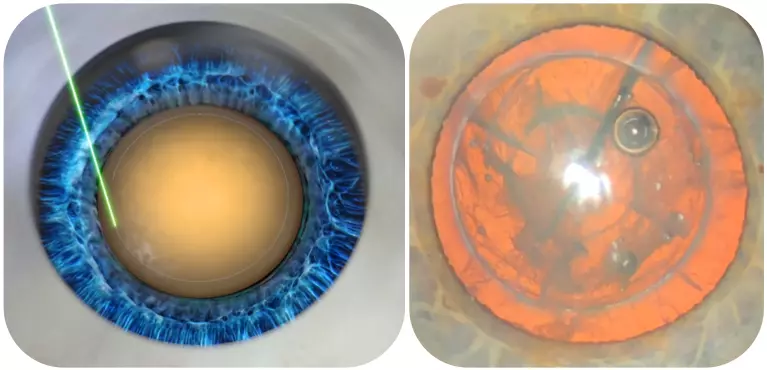
Figure 4.
(Left) Model of the laser applying its energy to make the capsulotomy. (Right) Real life picture of a capsulotomy and fragmentation pattern. Note the perfectly circular, positioned, and sized capsulotomy, and the fragmentation pattern in the cataract.
If the opening is too large, the lens implant may not be positioned perfectly, and if the opening is too small, it can lead to complications during the surgery, including not being able to get the cataract out of the eye safely.
Making an exactly 5mm, circular, centralized opening in this structure inside the eye can be challenging…for the human hand… but not for modern lasers.
In addition to the “capsulotomy”… there are many other delicate steps that the laser similarly performs in a more precise way than the human hand, thereby adding safety to your surgery. The steps include the incisions, astigmatism management, and the fragmentation of the cataract. We’ll touch on these other steps later in the article.
Simply put… the precision and consistency of lasers for this delicate and critical step of the surgery is superior to even the most experienced surgeons.
Laser Cataract Surgery is More Gentle
By being “more gentle”, laser cataract surgery can result in less inflammation and swelling after surgery, which can have a direct impact on the clarity of your vision after surgery – both in the short term and long term.
To illustrate this… Let’s discuss one of the most important parts of cataract surgery… Let’s discuss the steps involved in actually removing your cataract!
To remove a cataract, it is typically broken up into smaller pieces, and ultrasound energy is then used to “emulsify”… or, basically, liquify… the hard cataract. This ultrasound energy results in inflammation and swelling after your surgery. In a perfect world, we’d like to keep the amount of inflammation and swelling as little as possible, as both lead to delayed healing or even complications after cataract surgery.
Less Swelling
Swelling in the cornea results in blurry vision after cataract surgery. There’s always at least a little bit of swelling, which can cause blurry vision for a few days. The more ultrasound energy used, the more swelling there is. In some patients, there can be so much swelling that the cornea is not able to clear it, and additional surgery is necessary to clear it up to improve vision.
Less Inflammation
Inflammation can similarly cause problems after surgery. Everyone has at least a little bit of inflammation after surgery, and this is why most patients are routinely put on anti-inflammatory eyedrops after their procedure. Inflammation can result in delayed healing of the cornea, or can even put patients at risk of having swelling of the retina, called cystoid macular edema, weeks to months after cataract surgery.
In laser cataract surgery, the cataract is “fragmented”, or broken up into small pieces without the use of ultrasound energy. You can think of the laser as “softening” the rock-hard cataract. The laser doesn’t entirely replace the need for ultrasound energy; however, by “softening” the cataract, it reduces the amount of ultrasound energy needed.

Figure 5.
(Left) Surgical planning screen showing the fragmentation grid pattern for an advanced cataract. (Center) Model demonstrating how the laser pattern is applied. (Right) Real life fragmentation pattern in a soft cataract. The fragmentation pattern can be customized to the density of the cataract and surgeon preference.
By reducing the amount of ultrasound energy needed in cataract surgery, it allows for a reduction in swelling and inflammation after surgery. This gives patients the best change of avoiding short and long-term complications from these issues. These features can be particularly beneficial in reducing the rate of complications in certain patients, such as patients with diabetes, fuchs dystrophy, and complex cataracts.
In summary, “more gentle” surgery means safer cataract surgery with less risk of complications from unwanted swelling and inflammation.
What is the Laser Cataract Surgery Recovery Time?
All of the previous features are intended to add up to reduce the recovery time. By being more precise, consistent, and gentle, there can be less inflammation and swelling after surgery compared to traditional cataract surgery.
In some patients, laser cataract surgery can accelerate healing by a few days. In other patients with more advanced cataracts, or other eye problems, it can mean a few weeks or even months. It can even make the difference between not needing additional surgeries to deal with complications. For example, it can help avoid prolonged recoveries from things like macular edema. In other cases persistent corneal edema can result in needing a corneal transplant.
Laser Cataract Surgery Fixes Astigmatism
Almost everyone has some astigmatism… Astigmatism causes blurry vision… Astigmatism can be fixed with laser cataract surgery.
First… Let’s quickly discuss what astigmatism is for those interested in the details…
The front part of the eye acts like a lens to focus light onto the retina, which acts like the ‘film in the back of a camera’. There are two lenses in the front part of the eye: 1.) your cornea, and 2.) the natural lens inside the eye.
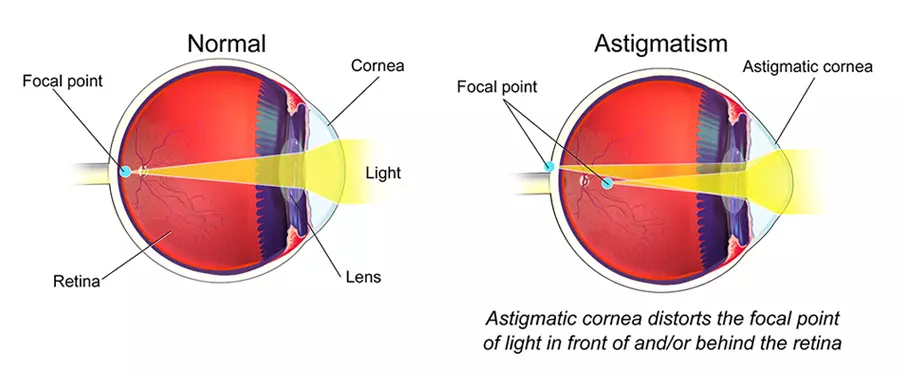
Figure 6.
(Top) The cornea and lens focus light onto the retina. For your vision to be clear, light should be focused precisely on the center of the retina. (Bottom) In an eye with astigmatism, light is not focused on the same spot on the retina, resulting in blurry vision. This can be fixed during laser cataract surgery.
We’d like it if the lenses in the front of the eye were perfectly spherical, so that light hitting any part of the cornea is focused perfectly on the retina. Unfortunately, for most people, their cornea isn’t perfectly spherical (even if you’ve never had astigmatism in your glasses!)… This means that unless your astigmatism is corrected at the time of cataract surgery, you’ll either need glasses or contacts afterward.
The good news is that Modern Cataract Surgery can treat astigmatism. Higher amounts of astigmatism are corrected with “Toric Intraocular Lens Implants”. Lower amounts of astigmatism can be corrected with the laser.
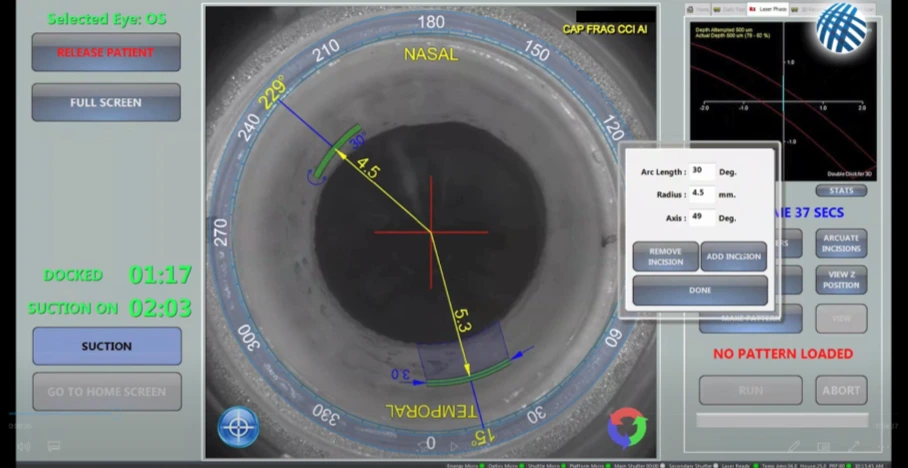
Figure 7.
Laser cataract systems can precisely change the shape of the cornea to treat astigmatism. This astigmatism treatment is customized to each patient by altering the size, shape, and position of the laser treatment.
The laser treats astigmatism by changing the shape of the cornea to be more spherical. Sometimes both “toric implants” and the laser are used together to treat astigmatism. Exactly how astigmatism will be addressed in your situation will be based on measurements taken by your surgeon.
Laser Cataract Surgery Ensures the Best Positioning of Your Lens Implant
After your cataract is removed, almost everyone gets a new lens implant put in its place. In Modern Cataract surgery, this lens implant is customized to your goals for your vision after surgery.
Once you’ve selected your vision goals, and your surgeon has chosen your lens implant… the most important final step in the process is to ensure your lens implant is positioned properly.
A properly positioned lens implant is 3 things: (i.) well-centered, (ii.) without being tilted, and (iii.) is stable inside the eye.
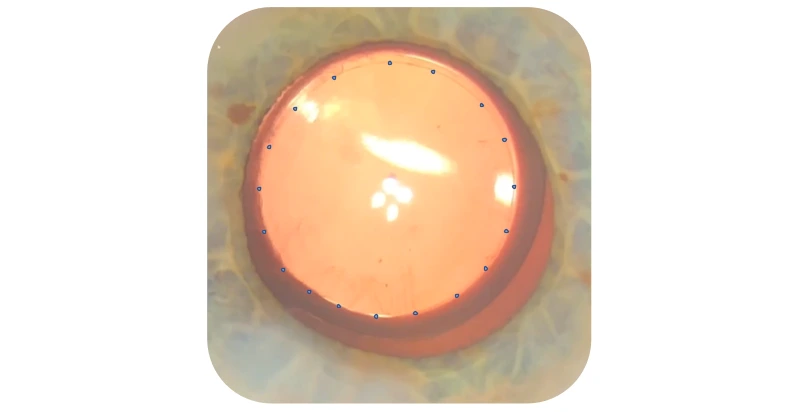
Figure 8.
A beautifully positioned lens implant following laser cataract surgery. The dots are used to highlight the perfectly circular capsulotomy edge which overlaps with the lens implant 360-degrees to ensure that the lens implant remains stable & well-centered for the rest of the patient’s life.
Perhaps the most important step in ensuring a well-positioned implant is the capsulotomy. When the capsulotomy is made in the correct position, with the correct size, and with a circular shape, it allows for the 6 millimeter implant to have support both behind it, and with 360 degrees of overlapping support in front of it. This uniform support from both the front and the back allows the lens to be held in place with great stability, well-centered, and without tilting.
A properly positioned lens is the final step to achieving the best vision possible after cataract surgery… and the best way to achieve that is with laser cataract surgery.
What Is The Cost For Cataract Removal By Laser?
Medical insurance typically covers laser cataract surgery, but not all of it. Medical insurance does not cover the advanced imaging or astigmatism management that’s performed by laser systems. They require patients to add an out-of-pocket expense to the amount that their insurance plan will cover. Every practice sets their own prices for laser cataract surgery. This price can vary based on region and surgeon experience.
A Decision That Will Last A Lifetime
Every surgeon wishes they could guarantee every patient the perfect outcome after surgery. As technology advances, we get closer and closer to that goal. Compared to 20 or 30 years ago, cataract surgery has advanced tremendously thanks to improved technology.
Our goal is for every patient to have the best outcome possible for their eyes. Choosing to have laser cataract surgery is one of the most important decisions you may ever make for your eyesight.

Written by Dr. Michael Shumski, M.D., M.S.E.
Dr. Shumski is a board-certified ophthalmologist specializing in cataract & refractive surgery at Magruder Laser Vision in central Florida.

